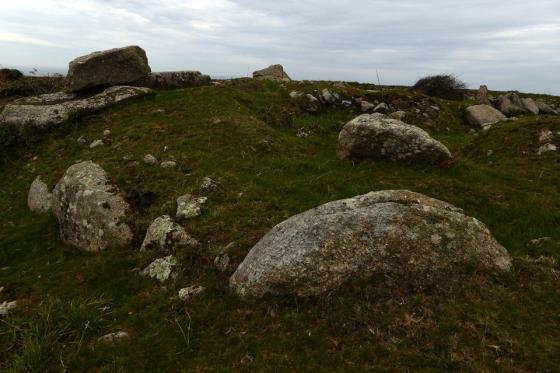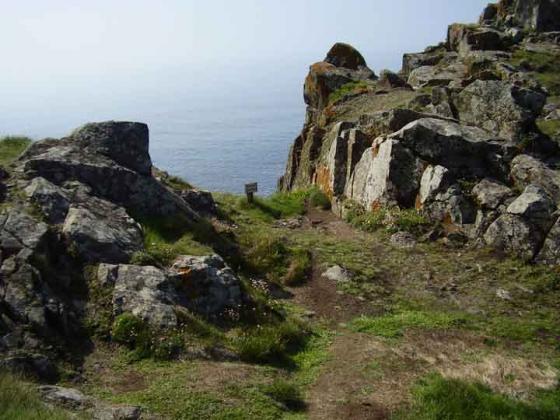Listed and described in the 2010 edition of Cheryl Straffon’s excellent “Earth Mysteries Guide to Ancient Sites in West Penwith” (Meyn Mamvro Publications).
Full description from Pastscape:
Centred at SW 38572798 is an elongated mound, oriented north north west to south south east. It is 26m long and from 5m to 6m wide, in a crest situation above a slight south slope, whereby it is clearly visible from the south east and all around to the west or seaward side.
The northern 11m consists of closely packed small stone, 0.1m to 0.2m across, mounded to create a flat top 1.3m wide and 0.9m high, for 6.5m. It then drops as a step of 0.3m to 0.4m and for the northern most 4.5m the top broadens to 3.2m. Seven firmly earthfast stones occur at irregular intervals by the edge of the flat top and towards the perimeter of the mound. Most protrude 0.1m to 0.3m but one of two leaning slabs is 0.9m high. The majority of the stones are blocks and connot be described as representing a kerb. On and beside the mound are seventeen loose blocks and slabs, many about 1m long and 0.7m wide; they may have been displaced from the mound or its perimeter but there are no obvious depressions to confirm this.
Extending southwards, for 15m, from this clearly man-made structure is a mass of outcrop with horizontal and vertical weathering, splitting it into a series of flat topped boulders. Initially level with the stone mound, they rise to 1.7m above it and at the southern edn are 3m above ground level. For 6m along the axis small stones have been packed against the outcrop and into crevices but there is little evidence of this in the southern 9m where the outcrop is more solid.
The cairn is most unlikely to be the result of clearance dumping and there are no indications of agricultural activity which might necessitate this and the suggestion, advanced in 1960 (SW 32 NE 23) seems erroneous.
In short the work appears to be a form of long cairn, but unusual in the utilization of outcrop to enhance its length and visibility.
.....
There is no sign of excavation (as opposed to minor robbing and displacement of stones) of the long cairn.







































































































































































